MobileDemand xTablet Flex 10A and Flex 10B
A pair of remarkably affordable 10.1-inch capacitive multi-touch tablet in custom-designed, preinstalled protective cases, one running Android, the other Windows 10
by Conrad H. Blickenstorfer
Ruggedized mobile computers can cost several thousand dollars, making them unaffordable or economically unfeasible for many potential customers. The MobileDemand xTablet Flex 10 models that we're examining in this review, on the other hand, start at just US$495. That's literally a fraction of what most of the leading rugged tablets cost.
How is this possible? It's because a few years ago, MobileDemand added to their lineup of heavy-duty rugged tablets a series of entry-level devices for customers who need more ruggedness than consumer-grade tablets can deliver, but at a price that is not prohibitive. The entry-level line began with the original xTablet Flex 8 and 10, and today includes both a Windows and an Android version of Flex 10, as well as a smaller budget handheld. In this report we're providing a comprehensive update on the current Flex 10 tablets available from MobileDemand.
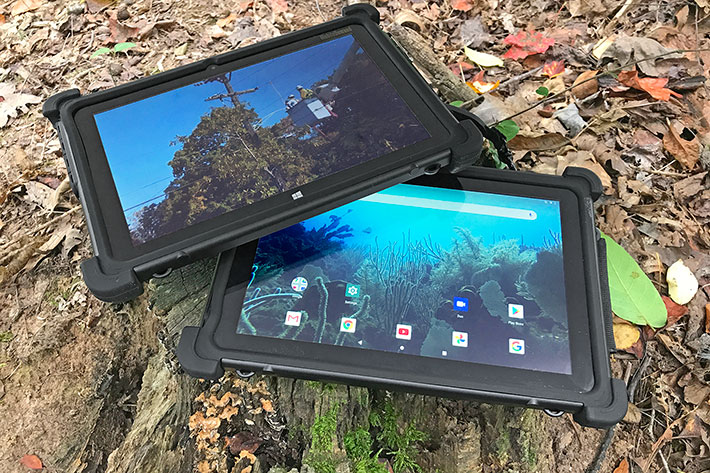
How can MobileDemand sell a rugged tablets at such low prices? They do it by packaging and pre-assembling standard "white box" Windows and Android tablets with well conceived shock-absorbing cases with protective bumpers and a carry handle. And also scratch-proof screen protectors and other touches and accessories essential to rugged tablets. So instead of having to search for a case that may or may not do the job, MobileDemand offers economy-priced tablets combined with a heavy-duty case designed by experts in rugged Tablet PCs. All for US$495 for an Android 9 version, and US$595 for one with Windows 10 Professional.
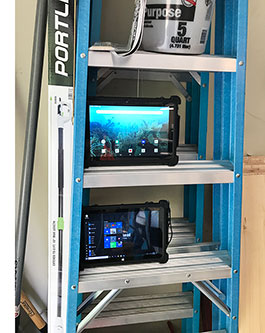 Even though third party protective cases are available for most handhelds and tablets (who doesn't instantly need one for today's fragile and wafer-thin consumer electronics), MobileDemand is one of very few suppliers of rugged tablets that also offers inexpensive versions packaged with a case. Which is surprising. Ever since Apple legitimized the tablet form factor a decade ago with the iPad, tablets have become an integral part of our lives, selling in the hundreds of millions. Inherently rugged tablets, however, only peripherally benefitted from that tablet bonanza. There are several reasons for that.
Even though third party protective cases are available for most handhelds and tablets (who doesn't instantly need one for today's fragile and wafer-thin consumer electronics), MobileDemand is one of very few suppliers of rugged tablets that also offers inexpensive versions packaged with a case. Which is surprising. Ever since Apple legitimized the tablet form factor a decade ago with the iPad, tablets have become an integral part of our lives, selling in the hundreds of millions. Inherently rugged tablets, however, only peripherally benefitted from that tablet bonanza. There are several reasons for that.
One is that traditional rugged tablet design wasn't appealing to customers used to trendy consumer tablets. Another is that even large corporate customers often balked at the high price of rugged tablets. Some high-volume enterprise buyers opted for budget-friendly consumer tablets in a third-party case. If they broke, they simply replaced them. There has been debate in the rugged industry for years as to the merits of putting consumer tech in a case. MobileDemand decided to find out for itself, and apparently it worked for them; they've offered the Flex line since 2014.
MobileDemand's Flex platform
MobileDemand's opinion of what makes a reasonable, logical lineup of rugged tablets is different. Having grown the company from modest beginnings catering to beer distributors, MobileDemand's leadership knows that one type of tablet doesn't fit all. Customers on a budget deserve as much attention as any other customer. So the company never offered bare-bones tablets that when properly equipped cost a whole lot more. They also never offered tablets with "scalable" performance, depending on what chip option was stuck inside. Because each level of performance requires a certain design and a certain build to work well.
Instead, MobileDemand offers entry-level solutions like the Flex line, and also expertly designed rugged cases for iPads and Microsoft Surface tablets; mid-performance systems able to handle most loads; and high-performance machines for compute-intensive fields. On top, of course, of suitable apps, extras, mounts, and accessories. The difference between the company's higher-end xTablets and the Flex models is that the former are designed and built as rugged high-performance tablets from the ground up, whereas the Flex line makes a ruggedized package available at the lowest possible price.
For the Flex models, MobileDemand sources solid generic tablets that meet a set of company's features and performance goals. MobileDemand custom-designs protective rubber boots with thick bumpers to securely cushion and cradle the tablets. That assembly then goes into a sturdy, custom-designed polycarbonate shell and backplate. The picture below shows that the Flex approach goes well beyond what any third party aftermarket case can offer:
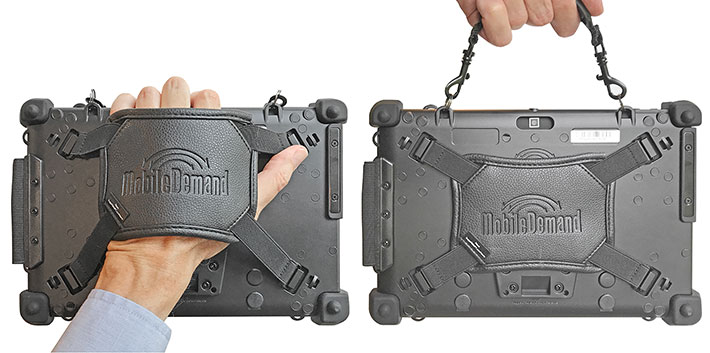
With their rugged cases, MobileDemand does far more than just sticking the tablet in a plastic shell. The backplate is designed to accommodate a briefcase carry handle, for secure mounting, for attaching a heavy duty handstrap, and it has an easily accessible holster for the unit's capacitive stylus. They design a rubber sleeve to cushion shock more effectively than any hard shell can alone. And most of this is included in the price.
What does the tablet inside look like? Most Flex customers will never find out because there's no need to remove the tablet from its armor, and the armor really isn't designed for frequent removal and re-insertion of the tablet.
The pictures below show the slender, stylish tablet at the core of the xTablet Flex 10A and the protective multi-layer casing.

What differentiates the xTablet Flex 10, either the Windows or the Android version, from buying a tablet and then a case for it is that it all comes preassembled and the case was designed by a company that has vast experience in rugged tablets. And there's an additional piece of protection that isn't visible in the pictures above: the xTablet Flex 10A also comes with a pre-applied screen protector that's not just a sheet of plastic but scratch-proof glass with a special oleophobic (fingerprint-resistant) coating. According to MobileDemand, it improves impact resistance by 20% — much welcome extra protection.
The below picture shows a close-up of the left side of both Flex 10 tablets inside their case. We removed the protective port covers for better visibility of the ports.

As far as I/O goes, the two tablets are almost exactly the same. From left to right, there is a small microphone hole, a standard 3.5mm audio in/out jack, then a USB-C port in the Windows tablet and a micro-USB port in the Android version, a micro HDMI port, a full-size USB Type A port (3.0 for Windows, 2.0 for Android), and finally a DC power jack. To the right of the ports, but inaccessible when the tablet is inside its shell, is a microSD card slot. This is one of the few reasons to ever take the tablet out of its armor. To the right of that is one of the two speakers.
We like the presence of a full-size USB port, as those are significantly less prone to damage than tiny micro connectors of any kind. The latter are sized to fit on phones and other small devices, but they really shouldn't be used in their present form in anything rugged. On the Windows version, we appreciate the reversible USB Type-C port.
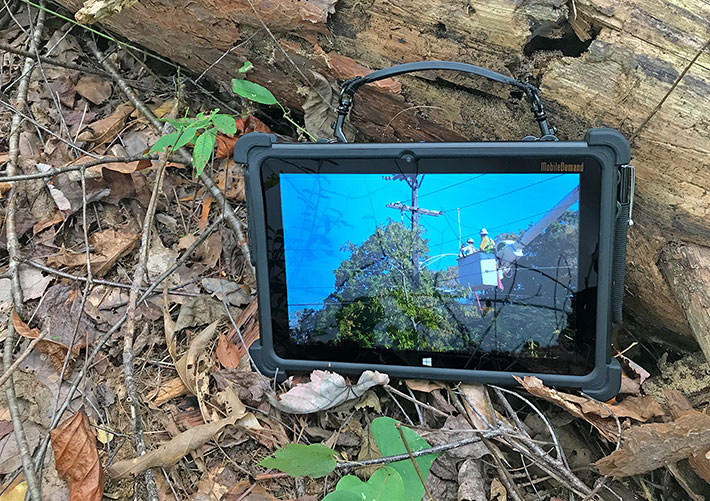
The (very well done) 2-in-1 option
Before we go any further, let's discuss the remarkable Flex 10 keyboard. It's a US$70 option and to work best also needs the US$32 Flex 10A easel that adds stability. Basically, an extra US$100 converts these xTablet Flex 10 tablets into productivity-enhancing 2-in-1 hybrids. And it looks like this:
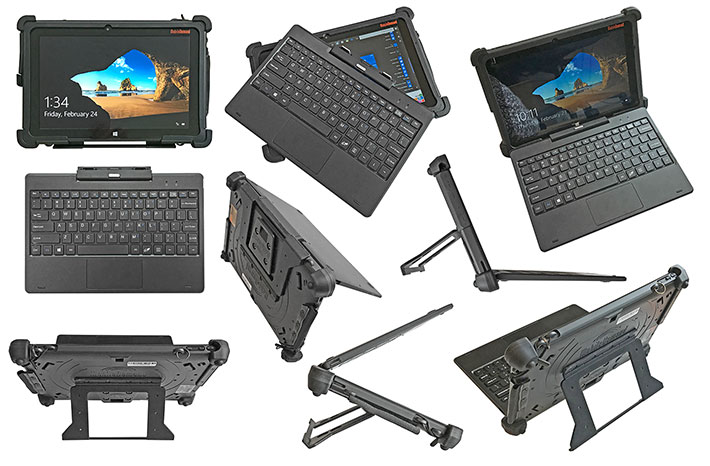
Since not everyone wants or needs the keyboard, MobileDemand actually offers the Flex 10 tablets with slightly different cases, one that has a cut-out at the bottom for the keyboard, and one that doesn't.
2-in-1 functionality has been a growing feature in the tablet market. It is popular enough that almost all the major players now offer detachable keyboards that add a lot of functionality. We definitely recommend it.
Unlike the wafer-thin and often marginally useful accessory keyboards available for consumer tablets, MobileDemand's keyboard provides full functionality, good key travel, and excellent tactile feedback. It also has a sturdy hinge that allows for a solid connection to the tablet. Combined with the easel, it makes for complete laptop functionality, should that be required.
About the only criticism we have is that the QWERTY layout is only 87%-scale. That makes it more difficult to use for touch typists. Slightly shrinking the punctuation and ancillary keys to the left and right of the QWERY layout would have easily allowed for a full-scale implementation.
Different processors and electronics
While the Windows and the Android versions of the Flex 10 look virtually identical on the outside, they are quite different inside. Windows and Android are fundamentally different. There are a few processors that can run either Windows or Android, but that's always a compromise. We're glad MobileDemand didn't make the mistake of running both OS platforms on the same electronics.
Android — the Android-based Flex 10A runs on a MediaTek MT8163 processor. While MediaTek doesn't nearly have the name recognition of Qualcomm with its Snapdragon chips that power almost half of all Android smartphones, the company is among the world's major chip makers.  Roughly 1/3 the size of QualComm, MediaTek generally specializes on the lower end of the Android device market.
Roughly 1/3 the size of QualComm, MediaTek generally specializes on the lower end of the Android device market.
Like most ARM-based CPUs, the MT8163 is a highly integrated System-on-Chip that incorporates four 64-bit ARM Cortex-A53 cores, Mali-T720 graphics as well as camera, storage and connectivity support. The MT8163 has been used in a variety of popular brand-name tablets. It was, however introduced in 2015, so we're not talking recent state-of-the-art tech.
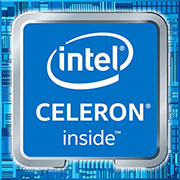 Windows — The Windows-based Flex 10B uses an Intel Celeron N4100 processor. Code-named "Gemini Lake," the N4100 is a quad-core processor launched late 2017 primarily for use in lower end notebooks. Compared to the Intel Atom X5-Z8350 that powered the previous generation of the Windows-based Flex 10, the N4100 is a very considerable upgrade in virtually every respect.
Windows — The Windows-based Flex 10B uses an Intel Celeron N4100 processor. Code-named "Gemini Lake," the N4100 is a quad-core processor launched late 2017 primarily for use in lower end notebooks. Compared to the Intel Atom X5-Z8350 that powered the previous generation of the Windows-based Flex 10, the N4100 is a very considerable upgrade in virtually every respect.
Whereas the older Z8350 was very much an low-cost, low-end processor, Intel had higher goals for the "Gemini Lake" Celeron chips, and that was reflected in its cost that was several times as high as that of the Z8350. When we benchmark-tested the last generation Windows-based Flex 10 in early 2017, it held its own against low-end competition and we described it as being a "competent performer given the relatively little computing power it has at its disposal." But we also found that it wasn't any quicker than its own predecessor model.
To provide an idea where the two xTablet Flex 10 models stand compared to their respective competition, we ran our standard Windows and Android benchmark suites on each model. The results are, of course, not directly comparable because Windows software and Intel hardware are fundamentally different from Android software and ARM hardware.
Flex 10B Windows benchmarks
For the Windows-based Flex 10B, we used our two standard performance benchmark suites on the test unit. Passmark Software's PerformanceTest 6.1 runs about 30 tests covering CPU, 2D graphics, 3D graphics, memory, and disk and then computes scores for each category and an overall PassMark score. As a cross check, we also always use the CrystalMark benchmark suite that tests single-core performance and various subsystems and then provides an overall score.
For comparison's sake, we included the benchmark data from MobileDemand's predecessor Flex 10 tablet, and added the numbers of four other 10-inch class tablets with various types of processors.
|
MobileDemand xTablet Flex 10B Benchmarks and Comparisons
|
|
PERFORMANCE COMPARISON
|
MobileDemand
|
MobileDemand
|
Estone
|
Handheld
|
RuggON
|
Zebra
|
|
Model
|
Flex 10B (2020)
|
Flex 10 (2016)
|
MJC-100 (2019)
|
Algiz 10X (2017)
|
PX501 (2018)
|
ET56 (2019)
|
|
Model
|
10" tablet
|
10" tablet
|
10" tablet
|
10" tablet
|
10" tablet
|
8 or 10" tablet
|
|
Processor Type
|
Intel Celeron
|
Intel Atom
|
Intel Atom
|
Intel Celeron
|
Intel Core
|
Intel Atom
|
|
Processor Type: Intel
|
N4100
|
X5-Z8350
|
X5-Z8350
|
N2930
|
i5-7300U
|
E3940
|
|
Code name
|
Gemini Lake
|
Cherry Trail
|
Cherry Trail
|
Bay Trail
|
Kabey Lake
|
Apollo Lake
|
|
CPU Clock
|
1.10/2.40GHz
|
1.44/1.92GHz
|
1.44/1.92GHz
|
1.83/2.16GHz
|
2.60/3.50GHz
|
1.40/1.80GHz
|
|
CPU Cores/Threads
|
4/4
|
4/4
|
4/4
|
4/4
|
2/4
|
4/4
|
|
Intel Graphics
|
UHD 6000
|
HD
|
HD
|
HD
|
HD 620
|
HD 500
|
|
CPU Mark
|
6,197.8
|
1,599.7
|
1,719.1
|
1,844.2
|
5,259.7
|
3,986.7
|
|
2D Graphics Mark
|
188.7
|
96.3
|
84.6
|
129.0
|
330.9
|
159.1
|
|
Memory Mark
|
607.2
|
324.3
|
385.2
|
340.9
|
1,775.5
|
440.3
|
|
Disk Mark
|
463.4
|
615.9
|
667.0
|
2,497.3
|
3,244.0
|
1,188.4
|
|
3D Graphics Mark
|
258.1
|
109.7
|
128.3
|
119.0
|
518.8
|
267.3
|
|
Overall PassMark
|
1,945.3
|
640.1
|
694.1
|
1,091.1
|
2,497.1
|
1,447.7
|
|
ALU
|
43,486
|
22,251
|
22,341
|
24,630
|
53,905
|
30,953
|
|
FPU
|
29,498
|
18,487
|
18,343
|
20,521
|
52,790
|
27,937
|
|
MEM
|
25,958
|
19,711
|
19,100
|
18,623
|
46,872
|
33,470
|
|
HDD
|
24,853
|
21,304
|
22,163
|
36,434
|
37,145
|
26,250
|
|
GDI
|
8,312
|
3,680
|
3,331
|
4,319
|
13,578
|
2,818
|
|
D2D
|
3,541
|
2,540
|
2,215
|
3,276
|
6,318
|
4,000
|
|
OGL
|
4,811
|
3,015
|
2,426
|
2,863
|
11,753
|
3,845
|
|
Overall CrystalMark
|
143,459
|
90,988
|
89,919
|
110,666
|
222,361
|
129,273
|
The results here speak for themselves. For an entry-level and bargain-priced product, the Flex 10B is a strong performer. That's in part due to Intel closing the performance gap between its processor families. A few years ago, Atom class processors were cheap and slow, and Core class processors expensive and fast. Even though the Celeron N4100 processor inside the Flex 10B is technically part of the Atom family, it's quite powerful. As a result, the Flex 10B is much quicker than what used to be expected from an Atom-powered system. It trounces its immediate Flex 10 predecessor, and offers performance not far behind Core-based systems.
Bottomline is that the current MobileDemand Flex 10B, isn't just a good performer given its low price, but a good performer period.
Flex 10A Android benchmarks
And here's what the performance situation looks like on the Android side. Do note that many current rugged Android tablets are viewed as part of customers' migration strategies from older Windows CE and Windows Mobile devices to Android, and not necessarily as direct competition for Windows 10 tablets.
|
MobileDemand xTablet Flex 10A Benchmarks and Comparisons
|
|
PERFORMANCE COMPARISON
|
MobileDemand
|
Handheld
|
Juniper
|
Panasonic
|
RuggON
|
Zebra
|
|
Model
|
Flex 10A
|
Algiz RT8
|
Mesa 3
|
Toughbook A3
|
PA501
|
M60
|
|
Model
|
10" tablet
|
8" tablet
|
7" tablet
|
10" tablet
|
10" tablet
|
6" tablet
|
|
Year tested
|
2020
|
2020
|
2020
|
2020
|
2019
|
2019
|
|
Processor Company
|
MediaTek
|
QualComm
|
QualComm
|
Intel Celeron
|
Intel Core
|
Intel Atom
|
|
Processor Model
|
MT8163
|
SD625/MSM8953
|
SD660
|
SD660
|
SD660
|
SD625/MSM89530
|
|
CPU Clock
|
1.50GHz
|
2.00GHz
|
2.20GHz
|
2.20GHz
|
2.20GHz
|
2.00GHz
|
|
CPU Cores
|
4
|
8
|
8
|
8
|
8
|
8
|
|
Graphics
|
Mali T720
|
Adreno 506
|
Adreno 512
|
Adreno 512
|
Adreno 512
|
Adreno 506
|
|
AnTuTu
|
47,394
|
100,381
|
175,615
|
172,458
|
162,015
|
81,954
|
|
Vellamo Metal
|
948
|
1,670
|
2,918
|
2,954
|
2,858
|
1,528
|
|
Vellamo Multicore
|
1,125
|
2,563
|
3,806
|
3,513
|
3,840
|
2,662
|
|
Vellamo Browser
|
1,486
|
2,590
|
5,758
|
5,650
|
5,921
|
NA
|
|
PassMark Mobile
|
1,749
|
3,998
|
5,801
|
4,473
|
10,011
|
5,924
|
Since until relatively recently, most rugged mobile computers were Windows-based, our Android benchmark database has far fewer entries. Benchmarks come and go, and results aren't as comparable across processor families as they are in the Windows world. In addition, fueled by the short consumer market product lifecycles and intense competition in state-of-the-art smartphones, there has been tremendous progress in ARM-based processor features and performance.
As a result, even high-end rugged tablets such as the Panasonic Toughbook A3 and the RuggON SOL PA501 are nowhere near the performance standards set by the latest smartphones. That said, the Flex 10A's performance is more than good enough for the kind of web-based and browser-based applications that often make up the majority of customer workloads. For example, running a terminal emulation or warehouse management system mounted on a forklift requires little more than running a good browser for such applications, the Flex 10 Android offers a great price to performance proposition: For the cost of a decent (non-iPhone) mid-range smartphone, customers get a nice 10-inch that's tough and rugged enough for almost all jobs in the field.
Power consumption
Battery life is always of major importance to mobile systems. And that's especially so for devices that have internal, non user-accessible batteries.
When we opened up the Flex tablets, we found a 7.4V, 3,000mAH battery in the Windows version, and a 3.7Volt, 6,000mAH battery in the Android tablet, both amounting to 22.2 watt-hours. That on the low end for tablets this size. MobileDemand's spec sheet suggests "up to 4-6 hours of battery life" for both versions.
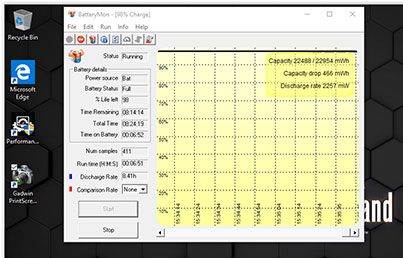 We used Passmark's BatteryMon utility to examine power draw of the Windows version under different settings.
We used Passmark's BatteryMon utility to examine power draw of the Windows version under different settings.
When running the drawdown test in the Windows "Best battery life" mode, with the tablet's backlight set to its dimmest, BatteryMon showed a very low 2.2 watt draw. With the backlight at 50%, that rose to 2.8 watts, and with the backlight at its maximum it rose to 3.7 watts. In Windows "Best performance" mode the battery draws were 2.4, 3.2 and 4.4 watts.
Given the battery's 22.2 watt-hour capacity, the lowest observed 2.2 watt draw translates into 10 hours of run time, and the highest observed draw of 4.4 watts equates to about five hours. This would make MobileDemand's estimates a bit conservative.
We were unable to measure the battery draw of the Android version. Android electronics usually draw less power, and so the Flex 10A may run somewhat longer between charges.
A look inside
While most xTablet Flex 10 customers might never remove the tablet from its protective enclosure, at RuggedPCReview.com we always want to know what's inside. A clean, logical internal layout is a good indicator of reliability and how well a device holds up over time and under adverse conditions.
Taking apart a Flex 10 — we're showing the Android Flex 10A version here — means you first have to separate the tablet from its elaborate protective plastic/rubber case. This requires VERY CAREFUL twisting and prodding to gently torque the tablet out of its cocoon.
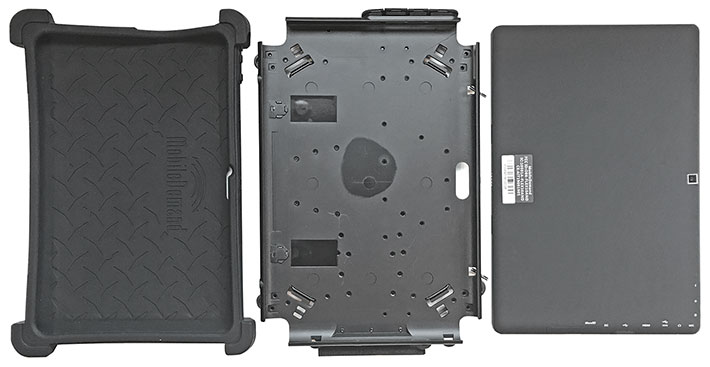
Once that's done, you're holding in your hands the bare Flex 10A, a remarkably sleek and elegant tablet device measuring 10.1 x 6.8 inches and perhaps a third of an inch thick, if that.
Anyone expecting, based on the very low price, to find a generic "white box" tablet inside the hefty custom casing may be surprised at the understated elegance of the Flex 10A tablet with its matte-black backside, the solid materials, and the precise manufacturing.
The Flex 10A housing consists of two black ABS plastic halves. The backside is an elegant matte-black. The front is glossy black with just a very thin bezel extending past the pre-applied screen protector. Separating the two halves requires careful prying the case open with a suitable plastic wedge tool, without breaking any of the small plastic snaps and retainers inside. We used a small triangular plastic opening pick, the kind you can see in all the fixit.com product teardown videos. Stick it into the thin gap between front and back somewhere, then gently glide it along to pop the snaps open one by one. There is no seal between the two halves as the Flex 10A is not a sealed unit.
Once separated, there are no wires or ribbon cables between the two halves. All the electronics are attached to the front side. The backside contains nothing but some metallic shielding and two sturdy anchors for the optional attachable keyboard. There is no frame; all components are mounted onto the front half of the housing. The picture below shows what things look like inside the Android-based Flex 10A:
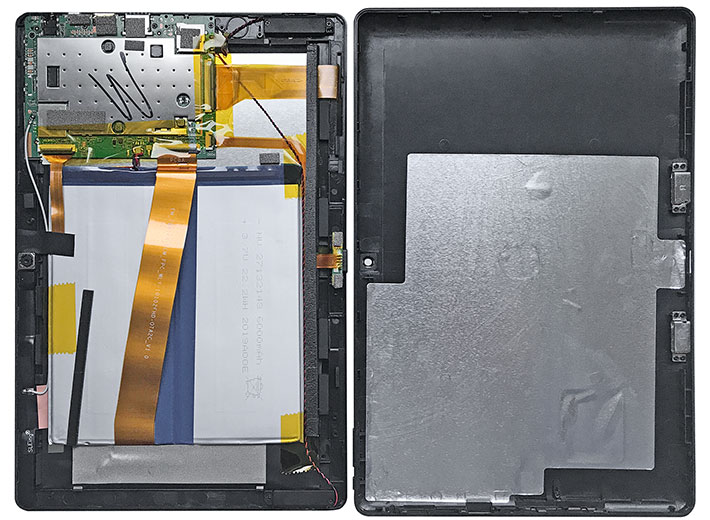
The motherboard measures a compact 100 x 72 mm and has all of its edge-mounted I/O concentrated along one side of the board. Almost needless to say, the Flex 10A does not need a fan. Its ARM processor and ancillary electronics generate so little heat that none is needed.
The majority of the interior real estate of the Flex 10A is taken up by its battery. It is a thin 5-1/2 x 5 inch affair that is not accessible from the outside and not user-replaceable. It's however accessible enough so that a service department could easily get to it and probably replace it.
Below is a look at the edge-mounted I/O of the Flex10A: The power jack, a USB Type A port, mini-HDMI, micro-USB, and a 3.5mm audio jack. In the center you can also see the micro-SD card slot which isn't accessible when the tablet is in its protective case. That may be a negative for some users. We assume MobileDemand had no choice as another large cutout might have weakened that side of the hard shell too much.

There are no miniPCIe or other expansion connectors visible, nor can you see the storage or RAM modules. That's because the tablet's eMMC (the "e" stands for "embedded") storage is part of the motherboard, as is Wi-Fi and RAM and just about everything else, much like in a smartphone.
Putting the two halves back together is easier than getting them apart. Align them and snap them back together, pushing each snap in turn, one by one. It takes just seconds. To get the tablet back into its protective multi-layered casing, you first pull the soft rubber boot over it, then push the assembly back into the rigid backplate. That requires a bit of pushing and prodding to get everything settled again in its proper place, but it's much easier than getting the tablet out.
If you're interested in what the Windows version looks like inside, here it is. Opening it up and putting it back together is identical to the Android version.
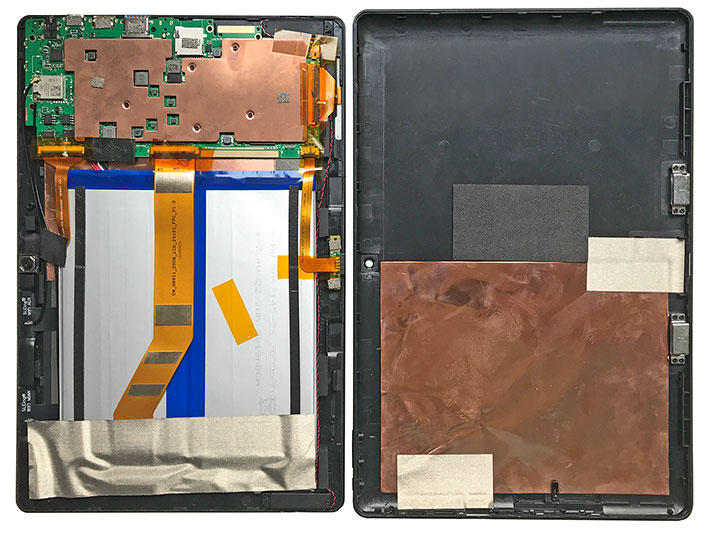
The capacitive multi-touch display
In order to keep the Flex tablets as affordable as possible, MobileDemand had to make some changes and concessions over the years that the platform has been available. The original Flex 10 display, for example, was excellent and offered full 1920 x 1200 resolution. Subsequent ones, while still good, haven't been in quite the same league.
In the current lineup both tablets measure a comfortable 10.1 inches diagonally, but while the Android version does offer the full HD 1920 x 1200 (224ppi) resolution display, the Windows version only has 1280 x 800 pixel resolution. That means just 149 pixels per inch instead of 224. That's the difference between Apple "retina" class sharpness where individual pixels are really visible anymore by the naked eye, and slight pixellation. No big deal, but it'd probably make more sense to have the Windows version with the higher res.
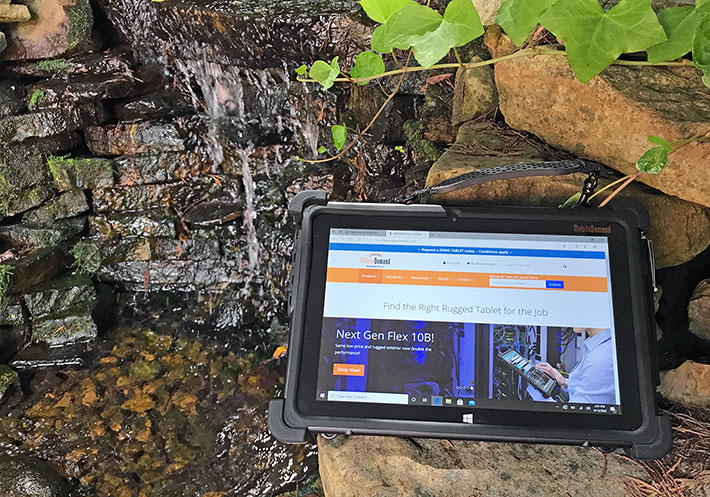
Since the Flex 10 tablets are rugged, many will be used outdoors, and that's where the brightness of the display makes a big difference. The original Flex 10 had a 350 nits backlight, but the two current models are down to 250 nits (we measured 262 and 255 nits for the Android and Windows versions, respectively). 250 nits is about as much as your average consumer laptop, but for any mobile computing device frequently used outdoors, brighter is always better.
To see how well it works, we compared the xTablet Flex 10B to an Apple iPad Air 2 whose retina display has a backlight strength of about 415 nits. Placed side by side outdoors on a bright afternoon in a semi-shaded area with their displays at maximum brightness, the iPad looked a little brighter, but the Flex tablet isn't far behind.
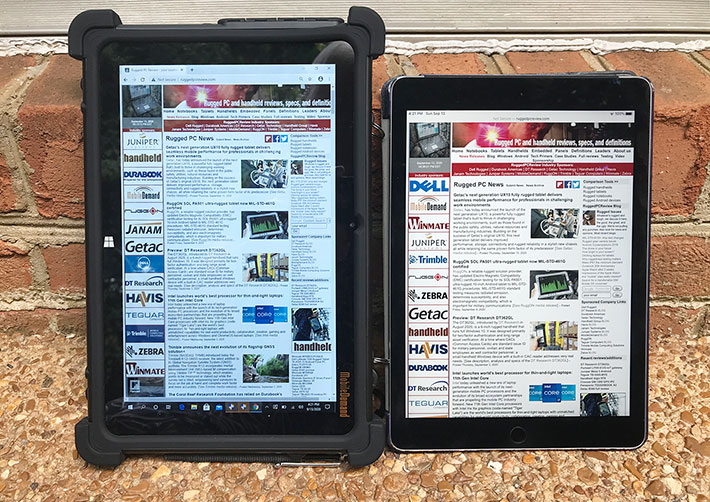
Both tablets have those fashionably glossy glass bezels and both display surfaces can, depending on the location and lighting, show fairly strong reflections. The images below show some of that. Unfortunately, strong reflections are what one has to expect from a modern consumer tablet. It's not the end of the world as most of us have become quite adept at angling our tablets so as to minimize reflections when using them outdoors.
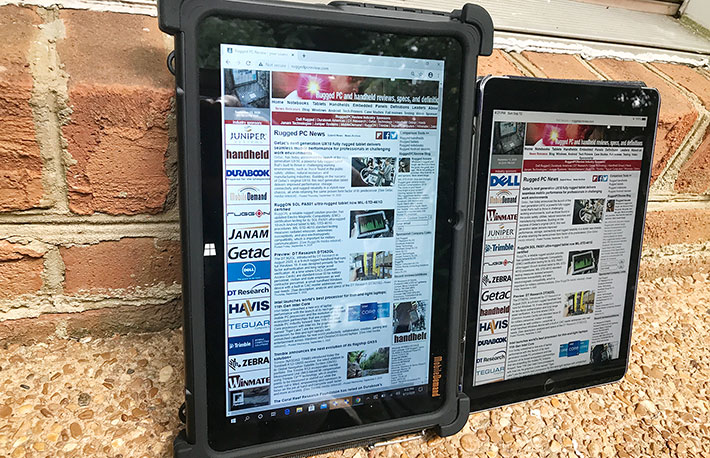
What we also consider very important in tablet displays is the viewing angle. Ideally, brightness, colors and contrast should not change regardless of what angle a display is viewed from. On the plus side, the Flex 10 LCD display itself aces that test. On the minus side, surface reflections get worse with increasing viewing angle.
MobileDemand supplies a capacitive pen with a foot-long lanyard. The pen is of the passive capacitive variety and has the broad tip that works well for tapping and panning, but not very well for precision work. A narrower tip stylus would come in handy, especially with the Windows version.
It's been our experience that capacitive touch controllers have very narrow tolerances of what they do and do not recognize as touch/contact. There are now some such controllers that can sense touch even from a small fraction of an inch away from the surface, and that makes such systems somewhat usable with thin gloves. The Flex 10 is not one of them, and it appears that the addition of the relatively thick protective screen cover, which adds a small bit of distance between finger and glass surface, means the Flex 10 requires a slightly firmer touch than it otherwise would.
Cameras
Both xTablet Flex 10 have two integrated cameras. The user-facing 2mp camera is for video conferencing, whereas the rear-facing 5mp camera with LED flash can be used for documentation purposes.
Cameras integrated into vertical and industrial market handheld and tablet computers have historically underperformed compared to even low-end dedicated cameras and the cameras available in every smartphone. Things have gotten considerably better, but still often not enough to eliminate the need for taking along a separate camera or using a smartphone for taking pictures or video.
The last generation Windows-based xTablet Flex 10 we tested in 2016 clearly benefitted from its generic consumer tablet underpinnings — its cameras were at least as good as we saw at the time even from high-end dedicated rugged devices. The 2016 Flex 10 could easily be used for project documentation, and we expected the cameras in the 2020 versions of the Flex 10 tablet platform to do even better.
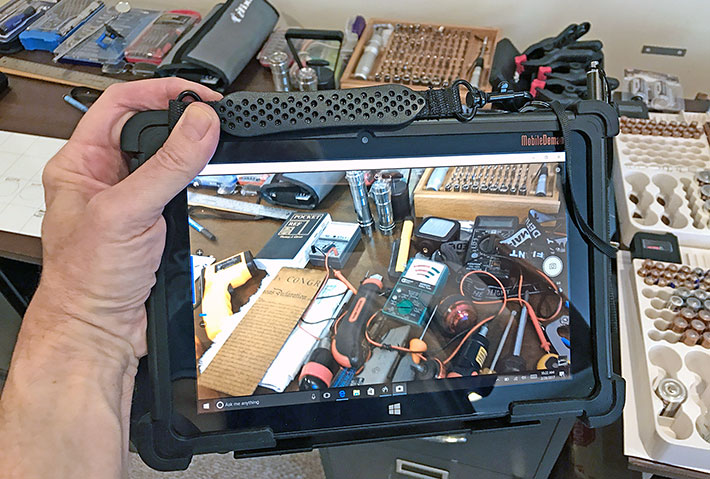
To find out we took our standard test pictures with both versions of the Flex 10 tablet.
Below are pictures shot with the Android-based Flex 10A documentation camera in its default 2560 x 1440 pixel resolution (click for full size):
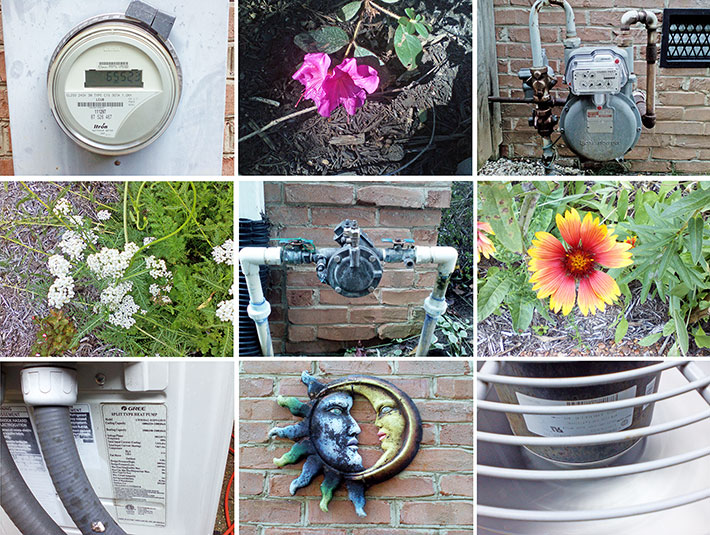
And below are pictures shot with the Windows 10-based Flex 10B camera in its default 2592 x 1944 pixel resolution (click for full size):
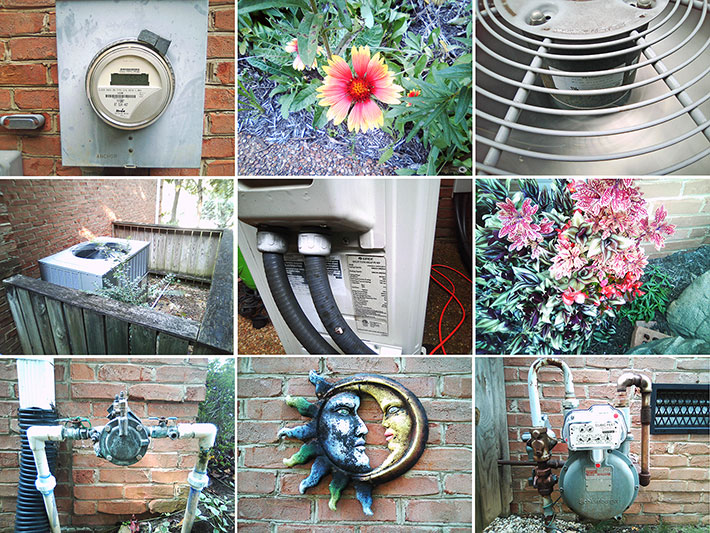
Of the two tablets, the Android version produced noticeably better pictures, good enough for occasional use when a contemporary smartphone or dedicated camera isn't handy. The camera in the Windows version didn't come close, which was a surprise as the camera in the older 2016 Windows-based Flex 10 had been so good.
For stills, the Android version had three images sizes (2560 x 1920, 1600 x 1200, and 640 x 480 pixel), 14 scene modes, 8 white balance settings, ISO from 100 to 6400, and 2 and 10 second self-timers. The Windows version camera app offers a framing grid, six resolutions ranging from 640 x 480 up to 2592 x 1944, whiteboard and document modes, and a "pro mode" that adds brightness control, manual focus, and a 5 or 10 second timer. Android version users have their choice of many downloadable camera apps, which the Windows version lacks.
For video, the Android version offered 1920 x 1080, 1280 x 720, 720 x 480, and 352 x 288 pixel formats, 12 scene modes, seven white balance settings, anti flicker, microphone on/off, EIS on/off, and up to 4X zoom. The Windows version seemed to have just one video mode, operated in wide-angle mode, and had brightness adjustment and manual focus.
Overall, we found camera performance to be workable, but modest.
Remarkable ruggedness
Here it gets interesting. While the bare Flex 10 tablets themselves are consumer-grade, once they are cocooned and protected inside their rugged MobileDemand cases they can easily survive the MIL-STD-810G 26 drops from four feet onto concrete. That's impressive. But it's not a surprise. It's often very low-tech solutions that make tablets capable of surviving rough handling and accidents out there in the field. An example are those blocky rubber bumpers on all four corners of the Flex 10 tablets. They aren't very elegant, but they get the job done better than the less prominent integrated corner protection in many expensive rugged tablets. Likewise, the unadorned soft rubber and hard polycarbonate shells are much less prone to scratching and denting than the elegant, high-tech materials used on many high-end rugged tablets.
MobileDemand says that you can also drop an 8-ounce steel ball from a meter onto its screen and it won't get hurt due to the special screen protector (we didn't try that).
Both tablets' operating temperature range is a bit narrower than that listed for MobileDemand's fully rugged gear, but 14 to 113 degrees Fahrenheit should cover most business users' needs.
Despite their impressive protective casing and nicely implemented protective rubber plug for all I/O ports, the Flex 10 tablets aren't considered sealed units and do not have an IP (Ingress Protection) rating. That means no working in driving rain or slushing around in brooks and streams. However, the special coating on the screen protector makes water perl off.
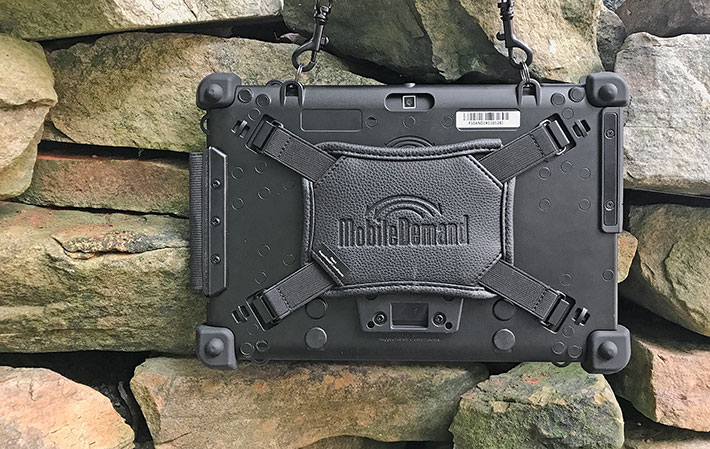
So, again, while the xTablet Flex 10 models look like fully rugged devices, they are consumer tablets inside a very intelligently designed case system. They can handle a lot more abuse than any sleek consumer tablet, but they are not sealed units and are not designed for use in truly harsh and unforgiving environments.
xTablet Flex mounting options
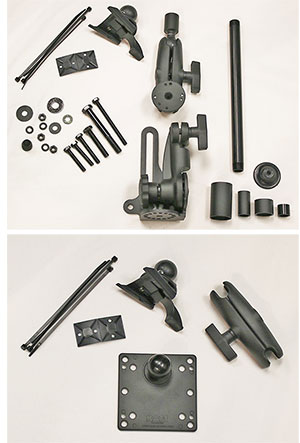 Most tablets used in business or on the job come with some kind of docking and mounting options, and the Flex 10 models are no different. And whereas MobileDemand did not offer the kind of full office and vehicle docks available for most of its higher end tablets for the original Flex 10, that has changed now and there are quite a few accessories mounting hardware options available..
Most tablets used in business or on the job come with some kind of docking and mounting options, and the Flex 10 models are no different. And whereas MobileDemand did not offer the kind of full office and vehicle docks available for most of its higher end tablets for the original Flex 10, that has changed now and there are quite a few accessories mounting hardware options available..
 For vehicle use, MobileDemand provides the professional-grade xTablet Flex Standard Vehicle Mount a flexible arm that makes for ergonomic access to the tablet in virtually any vehicle.
For vehicle use, MobileDemand provides the professional-grade xTablet Flex Standard Vehicle Mount a flexible arm that makes for ergonomic access to the tablet in virtually any vehicle.
The mount features a quick release mechanism for rapid switching from vehicle to field operations. Included in the package is the previously available Snap Mount no-drill base that attaches to the passenger seat floor bolt that secures the passenger seat to the floor.
Also available is the xTablet Flex Standard Wall Mount. It includes a Snap Mount plate that attaches to the back of the Flex device, and arm, a wall plate and all the anchors a and ties to mount the Flex tablet on a wall.
The image to the right shows the components of the two kits, the one above the no-drill base installed in a vehicle.
Bottom line: MobileDemand xTablet Flex 10A
With their two 10-inch xTablet Flex 10 tablets, MobileDemand presents a couple of entry-level rugged tablets with entry-level prices. The Android 9 version is $495, and the Windows 10 version $595. Both tablets employ MobileDemand's unique concept of merging basic modern consumer tablets with specially designed and preinstalled ruggedness armor. The protective layered casing is better than pretty much any after-market case. These rugged tablet offerings bust the old adage that you get what you pay for; MobileDemand gives you more than what you pay for. There are some concessions, of course, but these deals are almost too good to be true.

And yet, true they are. Weighing just 2-1/4 pounds including case, handle, handstrap and capacitive pen, MobileDemand's 10.1-inch "entry-level" thin-and-lights offer a deal for customers who seek the convenience, low cost and ease of use of a consumer tablet in a package that's better protected and doesn't cost nearly as much as a fully rugged (or even semi-rugged) tablet.
With Android dominating the global smartphone market and coming on strong in tablets, too, it makes sense for MobileDemand to provide tablets both in Windows and Android versions. The Windows version's quad-core Intel Celeron N4100 processor packs quite a punch and makes it much more powerful than its Intel Atom-powered predecessor. The quad-core MediaTek processor in the Android version can hold its own, but its relative position in the Android pecking order is lower than that of the Intel chip in the Windows realm.
Both Flex 10 tablets have a reasonably bright and vibrant display with 1280 x 800 pixel resolution, a perfect viewing angle from all directions, and no color shifts. The 10-point capacitive multi-touch screens are quick and responsive. The included broad-tip capacitive stylus works fine with Android, but Windows would benefit from a narrower tip.
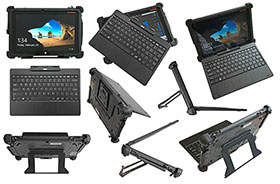 For inexpensive thin-and-light tablets the Flex 10 models have good onboard connectivity, including full-size USB 3.0, micro-HDMI and audio, as well as USB-C (Windows) and micro-USB (Android). The 2mp and 5mp cameras offer fair performance, with the Android version the better of the two.
For inexpensive thin-and-light tablets the Flex 10 models have good onboard connectivity, including full-size USB 3.0, micro-HDMI and audio, as well as USB-C (Windows) and micro-USB (Android). The 2mp and 5mp cameras offer fair performance, with the Android version the better of the two.
Inside its excellent rubber and polycarbonate casing, the xTablet Flex 10 models are remarkably well protected and can handle a good deal of abuse. These are not a sealed units though, so no dunking. Temperaturewise, the tablets can handle almost anything.
Offering good performance, very low power draw, decent displays, and surprising ruggedness, the fanless xTablet Flex models represent a compelling low-cost tablet option for anyone who needs Windows or Android on tough jobs. They aren't as bullet-proof as fully rugged device, but close enough.
We highly recommend the optional keyboard and easel that convert the Flex 10 models into remarkably cohesive 2-in-1 tablet/laptop hybrids.
Overall, the very low cost means some compromises. Which is fine; many enterprise and business applications only need entry-level features, so this is more than adequate at a price point that is hard to beat.
-- Conrad H. Blickenstorfer, September 2020
MobileDemand xTablet Flex 10A and Flex 10B Specs:
| Model
| xTablet Flex 10A
|
xTablet Flex 10B
|
| Type |
Thin-and-light rugged Android Tablet PC
|
Thin-and-light rugged Windows Tablet PC
|
| Added |
Full review 09/2020
|
Full review 09/2020
|
| Processor |
Quad-core MediaTek MT8163
|
Quad-core Intel Celeron N4100
|
| Processor speed |
1.30GHz
|
1.10GHz, 2.40GHz burst frequency
|
| Scenario Design Power |
unknown |
2 watts |
| Display Chipset |
Mali T720 |
Intel UHD Graphics 600 400 |
| OS |
Android 9.0 Pie GMS |
Windows 10 Home or Professional |
| Memory |
3GB PCDDR3 |
4GB RAM LPDDR4 |
| Display |
IPS LCD, 250 nits (262 nits measured) |
IPS LCD, 250 nits (255 nits measured) |
| Display size/res |
10.1-inch, 1920 x 1200 pixel, 224 ppi
|
10.1-inch, 1280 x 800 pixel, 149 ppi
|
| Digitizer |
10-point procap/capacitive stylus |
| Keyboard |
Optional detachable keyboard
|
| Storage |
128GB |
128GB eMMC |
| Expansion slots |
1 x microSDHC/SDXC |
1 x microSDHC/SDXC |
| Housing |
ABS plastic tablet in rubber and polycarbonate housing/case |
| Size |
10.5 x 7.2 x 0.7 inches (267 x 182 x 18mm)
|
| Weight |
2.25 lbs. (1.0 kg) with case, handle and hand strap |
| Operating temperature |
14° to +113°F (-10° to +45°C) |
| Humidity |
5 to 95% non-condensing |
| Ingress protection |
Not rated
|
| Drop/shock |
MIL-STD 810G, 516.6 IV (4 feet) |
| Power |
Li-Ion 22.2 watt-hours ("4-6 hours") |
| Cameras |
2mp camera front, 5mp camera with LED flash rear |
| Sensors |
Accelerometer
|
Accelerometer
|
| USB Type A |
1 x USB 2.0 |
1 x USB 3.0 |
| USB Type C |
NA |
1 x USB-C |
| Micro-USB |
1 x micro USB OTG |
NA |
| HDMI |
1 x mini-HDMI |
| Audio |
1 x 3.5mm audio jack |
| Wi-Fi |
Bluetooth 4.0
|
Bluetooth 4.2
|
| Security |
DUKPT
|
TPM 2.0
|
| Price |
US$495 with Android 9.0 Pie GMS |
US$595 with Windows 10 Professional |
| Contact |
xTablet Flex 10A web page |
xTablet Flex 10B web page |
(copyright 2020 RuggedPCReview.com)




